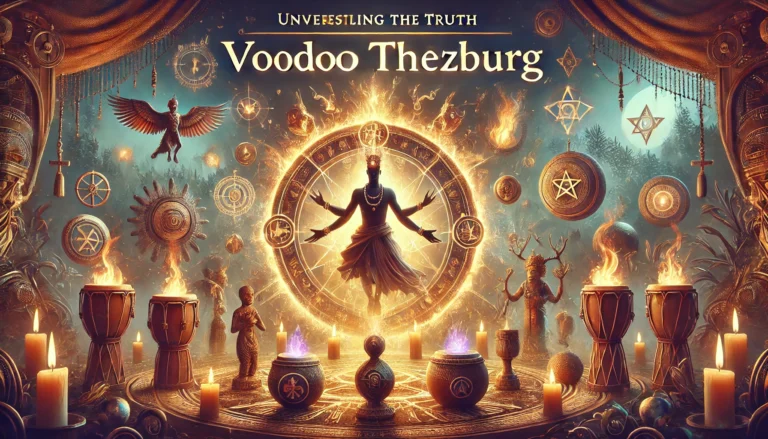Thezburg Voodoo is a rich spiritual tradition rooted in African ancestry, intricately woven into the cultural fabric of communities across the globe. Unfortunately, the phrase misunderstanding voodoo thezburg encapsulates a challenge practitioners face: a widespread lack of understanding fueled by myths and media portrayals. This article delves into the realities of Thezburg Voodoo, exploring its beliefs, practices, and cultural significance while addressing common misconceptions.
Origins and Core Beliefs of Thezburg Voodoo
Thezburg Voodoo originated from the fusion of African spiritual practices brought to the Americas by enslaved people. At its heart lies the belief in the Loas—spiritual entities serving as intermediaries between the physical and divine realms. Each Loa is associated with specific aspects of life, nature, and ancestry, and practitioners honor these spirits through rituals, music, and dance.
Central to Thezburg Voodoo is a profound respect for nature and ancestors. Practitioners believe that maintaining harmony with the spiritual and natural worlds is vital for personal and communal well-being.
Rituals and Their Significance
Honoring the Spirits
Rituals in Thezburg Voodoo serve as a bridge between the human and spiritual worlds. These ceremonies often involve drumming, chanting, and dancing, which are believed to invite the Loas to interact with the living. During certain rituals, spiritual possession may occur, wherein a Loa communicates directly through a practitioner.
Talismans and Symbols
Sacred symbols such as the Veve and handcrafted talismans play a crucial role in rituals. These items are used to invoke specific spirits, offer protection, and foster healing. Talismans, made from natural materials, are imbued with intention and spiritual significance.
The Influence of Syncretism
Thezburg Voodoo’s survival and evolution owe much to syncretism, the blending of African spiritual traditions with Christianity. This fusion was born out of necessity, as practitioners hid their beliefs under the guise of Christian worship during colonial oppression. Today, elements like saints and church rituals coexist seamlessly with traditional Voodoo practices, showcasing its adaptability and resilience.
Misunderstanding Voodoo Thezburg
The keyword “misunderstanding voodoo thezburg” highlights the ongoing struggle against misrepresentation. Pop culture has often depicted Voodoo as sinister, emphasizing curses and dark rituals. However, these portrayals ignore its true nature as a practice centered on healing, protection, and spiritual growth.
Ethical Dimensions of Voodoo
Thezburg Voodoo emphasizes the ethical use of spiritual practices. While it acknowledges the existence of “white” and “black” magic, the focus is overwhelmingly on positivity, healing, and fostering harmony. Ethical principles guide practitioners to live in alignment with the natural and spiritual worlds.
Cultural Significance of Thezburg Voodoo
Art and Music
The rhythms and themes of Thezburg Voodoo have inspired global music genres such as jazz, blues, and soul. These art forms often reflect the spirituality and resilience embodied by Voodoo practitioners.
Festivals and Community Bonds
Celebrations like Fête Gede, honoring the spirits of the dead, are vibrant demonstrations of Thezburg Voodoo’s communal spirit. These events blend joy and reverence, strengthening connections among participants and paying homage to ancestors.
A Way of Life
For many, Thezburg Voodoo transcends religion—it is a lifestyle. From daily rituals to communal ceremonies, it provides guidance, healing, and a sense of belonging.
Adapting to Modern Times
The Role of Technology
Modern practitioners of Thezburg Voodoo have embraced technology, connecting through online communities and sharing knowledge globally. Virtual rituals and ceremonies allow practitioners from diverse backgrounds to participate, fostering inclusivity while preserving traditions.
Western Curiosity and Respect
Thezburg Voodoo has attracted interest from Western audiences, some seeking alternative spiritual paths. However, genuine understanding requires respect for its cultural roots and an avoidance of superficial appropriation.
Dispelling Myths About Thezburg Voodoo
By confronting the misunderstanding voodoo thezburg head-on, we can shift perceptions and honor its profound legacy. Education is key to appreciating this rich tradition and its emphasis on healing, community, and ethical living. Understanding its true essence allows us to celebrate its contributions to culture and spirituality.
FAQs About Thezburg Voodoo
- What are the core beliefs of Thezburg Voodoo?
Thezburg Voodoo centers on the Loas, spirits that bridge the human and divine realms, and emphasizes harmony with nature and ancestors. - Why is Thezburg Voodoo often misunderstood?
Misrepresentation in media, portraying it as dark or malevolent, obscures its true focus on healing and community. - How do rituals in Thezburg Voodoo work?
Rituals involve music, dance, and sacred symbols to honor spirits, seek guidance, and foster spiritual connections. - Is Thezburg Voodoo the same as Haitian Vodou or Louisiana Voodoo?
While related, Thezburg Voodoo has distinct practices and cultural influences, making it unique among Voodoo traditions. - Can anyone practice Thezburg Voodoo?
Yes, but it requires respect for its traditions and cultural significance to ensure authenticity and avoid superficiality.

